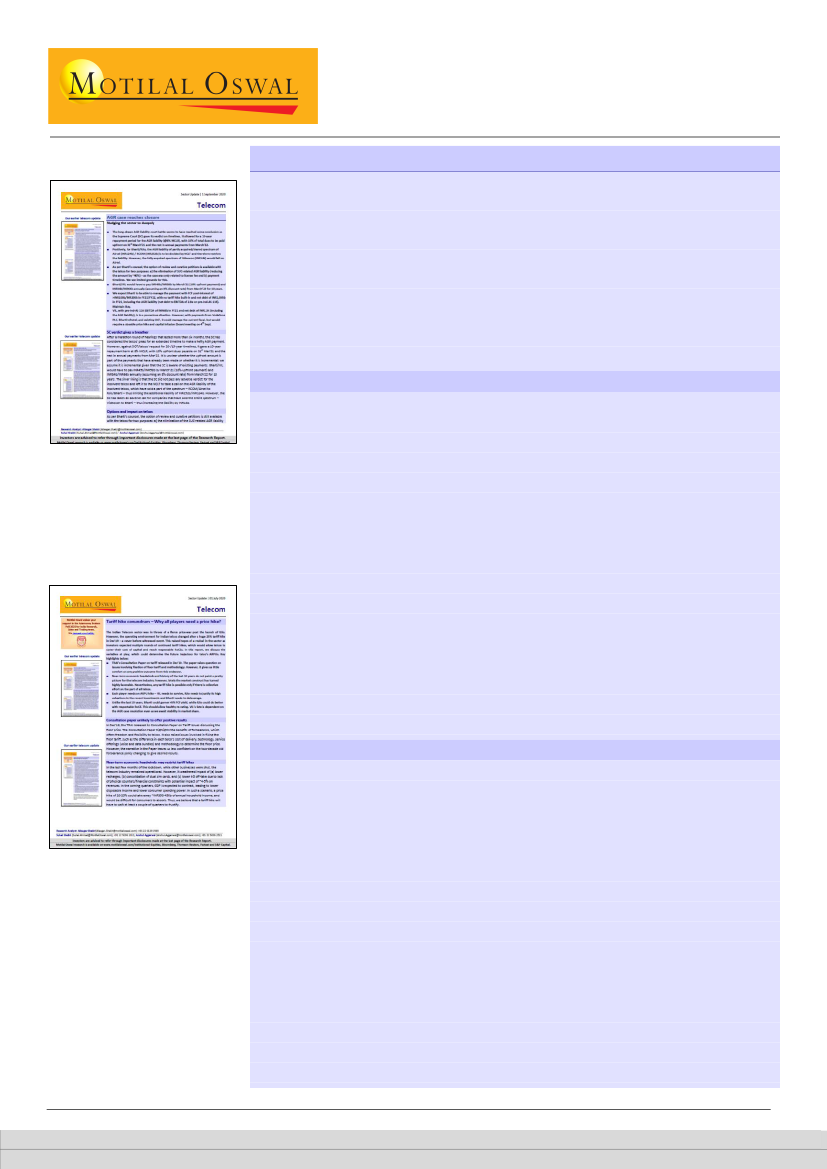
Telecom | Update
Sector Update | 16 October 2020
Telecom
Our earlier telecom update
The 5G Saga!
The Indian telecom industry is seeing capex peak out (particularly for Bharti and RJio)
and increased free cash flows (FCF). However, risks have started emerging due to the
increased capex toward 5G technology upgrade and the upcoming spectrum renewal.
In this report, we discuss the global progress of 5G, spectrum and network dilemma
and the ecosystem development. We have also made an attempt to work out the
potential investments and timelines of 5G and spectrum renewal.
We believe that (a) investments in 5G is still some time away and may be spread over
~5 years cushioning the impact, (b) the one-time spectrum renewal is a bit delayed
and could be managed through the existing FCF of Bharti and RJio, (c) the shrinking
number of telcos in India may restrict risks of over-bidding.
5G progress: How far away is it for India?
Our earlier telecom update
Historically, India has been about 10 years behind developed countries in terms
of technology upgrades. However, the timeline for 4G was shorter as a new
player forced the entire ecosystem to upgrade with its will and vigor.
With no new players, nascent use cases, limited incremental revenue potential,
spectrum woes along with an inherently low ARPU structure in India, we believe
telcos may wait for the 5G technology to stabilize globally (more on this below)
and see reduction in equipment cost, before deploying fresh technology, which
could take 3-4 years.
This brings us to the global progress on 5G. With commercial launches done in
26 countries by operators (as at Jan’20), clearly 5G is gaining fast traction. 5G
subscribers though merely 10m in CY19, are estimated to increase to 2.8b by
CY25. However, the recent COVID-19 crisis has dented its pace of progress.
The US, South Korea and China are leading the 5G race. China is aggressively
ramping up its 5G network and has a target of adding 600k sites by CY20 (by its
top-3 operators). This could be the key trigger for global 5G acceptance over the
next couple of years. However, reduction in device costs and rise in use cases
are equally important trigger points to increase traction in global 5G progress.
In a spectrum-starved country, most good quality sub-GHz and mid-band
spectrum are already under existing 2G/4G technology use. In India and globally,
there is an option to deploy 5G in the mid-band (3,300-3,600MHz) and the
700MHz band, until the spectrum in other sub-GHz band is eventually re-
farmed.
While both bands have sufficient quantity available for seamless 5G service, the
pricing of 700MHz is exorbitant at INR328b for 5MHz spectrum. Therefore, the
mid-band spectrum is best suited as it is priced lower at INR4.9b/MHz with
healthy available quantity.
However, given the coverage related difficulty of the mid-band spectrum, telcos
may deploy 5G with a fallback dependency on 4G. This could initially restrict 5G
investments significantly to only high data consumption locations.
Also, the recent initiatives on O-RAN (an interoperable network equipment
disintegrating hardware with software) and Reliance’s (RIL) in-house 5G product
development are steps that should help telcos create a fungible network with
flexibility to switch vendors as per their requirements/pricing.
The spectrum and network dilemma
Research Analyst: Aliasgar Shakir
(Aliasgar.Shakir@motilaloswal.com)
Suhel Shaikh
(Suhel.Ahmad@MotilalOswal.com) /
Anshul Aggarwal
(Anshul.Aggarwal@motilaloswal.com)
Investors are advised to refer through important disclosures made at the last page of the Research Report.
Motilal Oswal research is available on www.motilaloswal.com/Institutional-Equities, Bloomberg, Thomson Reuters, Factset and S&P Capital.